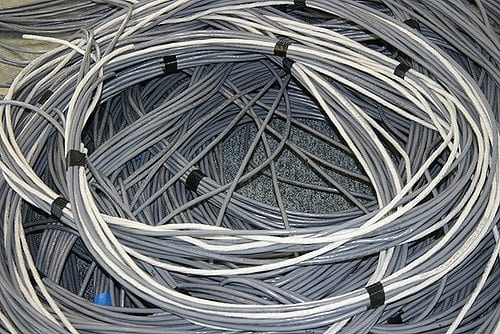Data Cabling for your office relocation
Relocating to a new business premises can be a stressful and expensive experience. Beyond the costs involved with space rental, utilities and other provisions for the new site, there are also allowances which must be made for the physical transfer of equipment and infrastructure.
With the increasing emphasis on virtualised methods of delivery for IT infrastructure and services, the correct disposition and configuration of physical cabling for enterprise data and communications handling may be pushed far down on an organisation’s list of priorities. But a logical and efficient data cabling system may become as critical to a company’s operations as the information in its corporate archives.
In this article, we’ll be looking at some of the factors to consider when planning and installing data cabling for your relocation to a new office.
Define Your Limiting Parameters
Office relocation requires a great deal of co-ordination and planning and being aware of your objectives and constraints with regard to data and communications is a good philosophy from the outset. Begin by asking some basic questions:
- What’s the available budget?
- What skills and human resources may be called upon?
- What are the existing data and communications technology needs of the business?
- What might be the organisation’s future needs for infrastructure and technology?
Consider What’s Available at the New Site
Unless you’re commissioning new-build premises, the site you relocate to will likely already have some kind of telecommunications, data, and power infrastructure in place. So, it will be necessary to conduct an assessment survey of the new site, to establish how or if the existing configuration of floor cavities, junction boxes, sockets and power outlets can cater for your existing and anticipated needs.
There may also be provisions in place for internet/network connectivity, so you’ll need to confirm what the existing bandwidth limitations are – and whether these will be sufficient for the requirements of your own business.
Map Out the Site’s Physical Infrastructure
Whatever facilities already exist, it’s probable that some degree of modification will be necessary to accommodate the unique characteristics of your organisation’s working practices and demands for data and communications’ provision.
Having made a preliminary assessment of the new site, you should proceed to make a room-by-room mapping of the physical provisions for data and communications infrastructure, resulting in a detailed visual representation of the new site. This plan/diagram may take the form of an overlay, juxtaposing:
- The physical layout of the new premises as they exist
- The physical layout you’ll need to set up the power, network, and telecommunications cabling for your business
There’ll probably be some give and take involved in this process (budget constraints, physical dimensions of the new building, etc.), and it may be necessary to devoted some time and resources to getting this detailed floor planning just right.
Consider Health & Safety – And Others
Establishing runs of data cabling to suit your business demands is all very well, but it’s also necessary to consider how the physical disposition of the wiring may affect visitors to your premises and the people actually using the equipment.
A maze of wires that connects all your IT and telecoms hardware but also serves as a potential death trap looking to break someone’s ankles, block access to emergency exits, or obstruct ventilation and cooling equipment may be functional from a business perspective – but it won’t do you any favours in terms of Health & Safety compliance.
Depending on your circumstances, there may be other compliance regimes (government/military, credit card processing, health care, etc.) that will require special provisions for the positioning of data assets, servers, or transaction processing equipment – and these aspects will need to be taken into consideration at the early mapping and design stages of your cable routes.
Allow for Future Expansion
Provisions will also need to be made to allow for the growth and maturing of your business, which may manifest as a need for increased bandwidth, more phone lines, greater power consumption, and so on.
While it’s impossible to predict exactly where you’ll be in a year or even several months’ time, it should be feasible (given your current set-up, market trends, and overall objectives) to make some sensible allowances for future growth. These might range from designating unused areas of floor and office space for the possible housing of hardware or servers, to subscribing to hosted services that allow for additional users and resources to be provided for on demand.
Consult Early
Besides your in-house IT staff (or a consultant, if you need to hire one), a number of professionals will necessarily be involved in the planning and execution of your relocation and the provision of data cabling for your new premises. These could include structural and electrical engineers, heating and ventilation specialists, telecommunications and network consultants, and cabling contractors.
There’ll be a lot of work streams to co-ordinate, information and suggestions coming in from various sources, and deadlines to meet. Assembling a team of reliable experts, someone from within your organisation to mediate and manage the various processes, and bringing these consultants into the relocation process early on will help the process to run more smoothly.
Use Structured Cabling
Ad hoc installations of data, network, and telecommunications cabling from separate contractors won’t give you the assurance of an integrated cabling system – and will increase your overheads in terms of managing and maintaining separate systems.
This emphasises the need for a structured cabling solution, which combines the wiring and connection needs of all your disparate systems into one co-ordinated network, installed and supported by an experienced, single contractor, such as LG Networks. Structured systems are also easy to use and administer, with a logical configuration and distinct socket connectors for data cabling, power, networks, and communications.
Allow for Changes
Both in your initial relocation and in subsequent months when changes in market and business conditions come into play, there may be a need for alterations in the configuration of your data cabling, and/or the provision of network and telecommunications resources.
The need for adaptability emphasises the importance of future-proofing – which may be readily accomplished through the use of a structured cabling system, and by the provision of IT and communications via hosted services which allow for the console-based management of accounts and the allocation of resources on demand.





